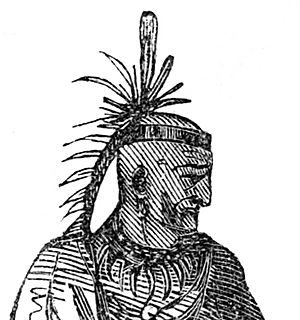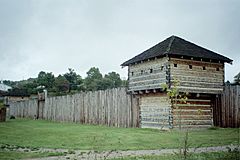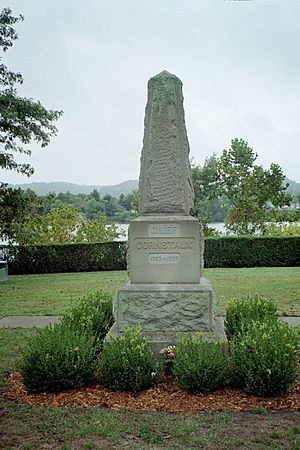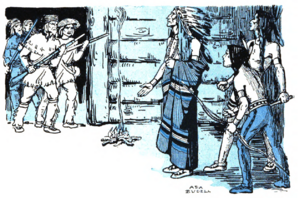Cornstalk (Shawnee leader) facts for kids
Quick facts for kids
Cornstalk
|
|
|---|---|

Detail of Cornstalk as illustrated in John Frost’s Pictorial History of Indians (1873)
|
|
| Died | November 10, 1777 Fort Randolph, Virginia (now West Virginia)
|
| Burial place | Point Pleasant, West Virginia |
| Nationality | Shawnee |
| Other names | Hokoleskwa, Colesquo, Keightughqua |
| Known for | Shawnee war leader |
| Relatives | Nonhelema (sister) |
Cornstalk (c. 1727? – November 10, 1777) was an important Shawnee leader. He lived in the Ohio Country during the 1760s and 1770s. His name in the Shawnee language was Hokoleskwa. This means "a blade of corn."
Not much is known about his early life. He might have been born in Pennsylvania. In 1763, he may have led a raid against British American settlers. This was during Pontiac's War. He first appeared in historical records in 1764. He was one of the hostages given to the British to end Pontiac's War.
As British American colonies grew, they moved into the Ohio Country. Cornstalk worked hard to protect the Shawnee homeland. He was the main Shawnee war chief in Lord Dunmore's War (1774). He led Shawnee and other Native warriors against the colonists. This happened at the Battle of Point Pleasant.
After losing that battle, he wanted the Shawnee to stay neutral. This was during the American Revolutionary War, which started in 1775. Many Shawnees fought against the Americans. They hoped to get their lost lands back. But Cornstalk feared that fighting would be very bad for the Shawnees.
In 1777, Cornstalk visited Fort Randolph. This fort was in Virginia (now West Virginia). He hoped to understand what the Americans planned to do. The fort's commander imprisoned him and three other people. Later, an American soldier was killed by Natives near the fort. Angry soldiers then killed Cornstalk and the other prisoners. His death made many Shawnees very angry. It also took away an important leader who wanted peace.
Contents
Biography of Cornstalk
Early Life and Background

We don't know much about Cornstalk's early life. He first appears in history in 1764. His birth year is not known for sure. Some old writings guess he was born around 1720.
Decades before Cornstalk was born, the Iroquois pushed the Shawnees out of the Ohio Country. One Shawnee group moved to the Wyoming Valley in Pennsylvania. This was near what is now Plymouth. A leader of this group was Paxinosa, a well-known Shawnee chief. Some missionaries who knew Cornstalk said he was Paxinosa's son or grandson. So, Cornstalk might have been born in that area.
Shawnees of Cornstalk's time belonged to one of five main groups. These were Mekoche, Chalahgawtha, Kispoko, Pekowi, and Hathawekela. Like Paxinosa, Cornstalk was part of the Mekoche group.
During the French and Indian War, fighting came to Pennsylvania in 1755. Paxinosa's group stayed neutral. In 1758, they moved to the Ohio Country to avoid the war. They built a new town called Wakatomika. This was on the Muskingum River. Other Shawnee people joined them there.
Some Ohio Shawnees did fight in the war. Years later, people said Cornstalk led a raid into Virginia in 1759. But these stories might not be true. Cornstalk may have fought in Pontiac's War (1763–1766). This was a big effort by many Native tribes. They wanted to stop British control of the Ohio Country. He is said to have led a raid into Virginia (now West Virginia) in 1763.
He first shows up in official records in 1764. He took part in talks with Colonel Henry Bouquet. He was one of the hostages given by his tribe. This was to make sure they followed the peace terms. Cornstalk was afraid for his safety. He escaped and went back home.
The Ohio Shawnees first lived in two main towns. These were Wakatomika and Lower Shawneetown. In 1758, Lower Shawneetown was left behind. People moved to smaller towns along the Scioto River. In the 1760s, Cornstalk started his own town on the Scioto. His sister, Nonhelema, also started a town there. She was known as the "Grenadier Squaw." Cornstalk's brothers, Nimwha and Silver Heels, were also important Shawnee leaders. Cornstalk had at least two sons, Cutemwha and Allanawissica. Cutemwha later became an important Shawnee chief in the 1780s.
Lord Dunmore's War (1774)
After Pontiac's War, the British made a rule in 1763. It created a border between their colonies and Native land. But this border did not last long. In 1768, a new border was set in the Treaty of Fort Stanwix. This treaty gave land south of the Ohio River to the British. This land is now West Virginia and Kentucky.
The Shawnees used this land for hunting. But they were not asked about the treaty. After 1769, settlers and land buyers moved into the area. This led to fights between settlers and Native people. The Shawnees began to organize other Native groups. They wanted to protect their hunting grounds from British settlers. In 1773, Cornstalk warned a man named Thomas Bullitt not to survey the land.
The situation became very serious in 1774. At least ten Mingo Indians were killed by white settlers. This was called the Yellow Creek massacre. The Mingos fought back against the settlers. It looked like war was about to start.
At Fort Pitt, John Connolly called out the militia. He worked for Lord Dunmore, the governor of Virginia. Cornstalk tried to stop the violence from growing. He sent his brother, Silver Heels, to help British traders. Silver Heels took them safely from the Shawnee towns to Fort Pitt. While at Fort Pitt, Silver Heels was shot and badly hurt by local militia. This event started Lord Dunmore's War.
Cornstalk was not the main chief of the Shawnees. Shawnees lived in towns that governed themselves. They did not have one central government. But in the 1760s, they started choosing a ceremonial leader. This leader was from the Mekoche group. He would speak for them with colonial leaders. The main chief in Cornstalk's time was Kisinoutha.
According to Shawnee custom, war chiefs took over during wartime. Cornstalk became the head warrior. He led other war chiefs like Blue Jacket and Black Snake.
The Shawnees and Mingos had far fewer fighters than the Virginians. So Cornstalk tried to get other Native allies. But British officials stopped other tribes from joining the war. This left Cornstalk with only about 300 warriors. These were Shawnee, Mingo, Delaware, and Wyandot fighters. They faced Dunmore's 2,300 men.
Dunmore planned to invade the Ohio Country from two sides. He led one group, and Colonel Andrew Lewis led the other. Cornstalk decided to attack Lewis's group first. He wanted to do this before the two armies could join. This started the Battle of Point Pleasant on October 10. During the long battle, Virginians heard Cornstalk encouraging his men. He told them to "be strong, be strong!"
The Shawnees at first had the advantage. But when more colonial soldiers arrived, the Shawnees were pushed back. Near sunset, Cornstalk led his warriors back across the Ohio River.
As Dunmore's armies moved further into the Ohio Country, some warriors wanted to keep fighting. Cornstalk told them, "then let us kill all our women and children, and go fight till we die." He meant that fighting more would lead to everyone's death. Cornstalk then arranged to meet Dunmore. He wanted to end the short war.
At the Treaty of Camp Charlotte, Cornstalk seemed to accept the Ohio River as the Shawnee land border. He gave four hostages, including his son. This was to make sure the terms were followed. A Virginia officer, Col. Benjamin Wilson, wrote about Cornstalk's speech. He said Cornstalk was as good a speaker as famous Virginia orators.
American Revolution and Death
The American Revolutionary War began soon after Dunmore's War. Cornstalk tried hard to keep his people neutral. In October 1775, Cornstalk and other Mekoche leaders met at Fort Pitt. They wanted to keep peace with the Americans.
In the summer of 1776, he also visited the British in Detroit. He hoped to be friendly with them too. But many Shawnees wanted British help. They hoped to get back the lands they lost to the Americans. Shawnees sent people to the Cherokees in Chota (now Tennessee). They asked for help. A young Cherokee chief, Dragging Canoe, agreed to fight. Shawnees and Cherokees then began working together against the Americans.
In the fall of 1776, Cornstalk went back to Fort Pitt. He told the U.S. Indian agent, George Morgan, that his people wanted peace. He said some young Shawnee warriors were acting without thinking. Cornstalk asked Morgan to send a message to the Continental Congress. This message explained Shawnee problems and offered friendship.
Cornstalk decided to move his followers to Coshocton. This was a neutral Delaware Indian town. By the winter of 1776, Shawnees were split. Some followed Cornstalk and wanted peace. Others were militant groups led by men like Blackfish. Even though Cornstalk and other Mekoche leaders made peace, other Shawnee groups did not agree. They did not want to lose their hunting grounds.
In October 1777, two Shawnees visited Fort Randolph. This American fort was built where the Battle of Point Pleasant happened. The fort's commander, Matthew Arbuckle, held them hostage. He decided to hold any Shawnees he found. Cornstalk's son, Elinipsico, arrived a few days later. He came to ask why they were being held. Cornstalk came to the fort soon after. All four were then held captive.
On November 10, an American soldier at the fort was killed. He was killed by unknown Native people nearby. In response, angry soldiers brutally killed Cornstalk, Elinipsico, and the other two Shawnees.
What Happened Next

Historians say Cornstalk's death is sometimes misunderstood. His killing did not cause the Shawnees to go to war against the Americans. Many militant Shawnees had already decided to fight. However, his death meant the Shawnees lost an important leader who wanted peace. It also convinced many Native people that Americans could not be trusted. More Shawnees joined the militant groups after his death.
Cornstalk's followers moved to Coshocton in 1778. His sister Nonhelema moved to Fort Randolph. She worked there as an interpreter and messenger for the Americans. She continued to work for peace, even after her brother was killed.
American leaders were very worried about Cornstalk's death. They thought he was their only hope for Shawnee neutrality. Patrick Henry, the first governor of Virginia, was very angry. He demanded that Cornstalk's killers be brought to justice.
The accused killers were named James Hall, Malcolm McCown, Adam Barnes, William Roane, and Hugh Galbreath. They were eventually put on trial. But their fellow soldiers would not speak against them. So, all of them were found not guilty.
Cornstalk's Legacy
Cornstalk was first buried at Fort Randolph. In 1840, his grave was found again. His remains were moved to the Mason County Courthouse grounds. When the courthouse was torn down in 1954, Cornstalk was reburied. This was at Tu-Endie-Wei State Park. This park is the site of the Battle of Point Pleasant.
Local stories grew about his dying "curse." People said it caused bad things to happen in the area. Some regional stories claim he got his revenge in the 1960s. They say he sent the mysterious Mothman to scare people in Point Pleasant.
A story about Aracoma, who was said to be Cornstalk's daughter, is well known. This is in Logan County, West Virginia. The story is performed each year as an outdoor drama. This happens at Chief Logan State Park. The city of Logan, West Virginia, was called "Aracoma" from about 1844 to 1907. It was named after her.
See also
- Chief Cornstalk Wildlife Management Area



